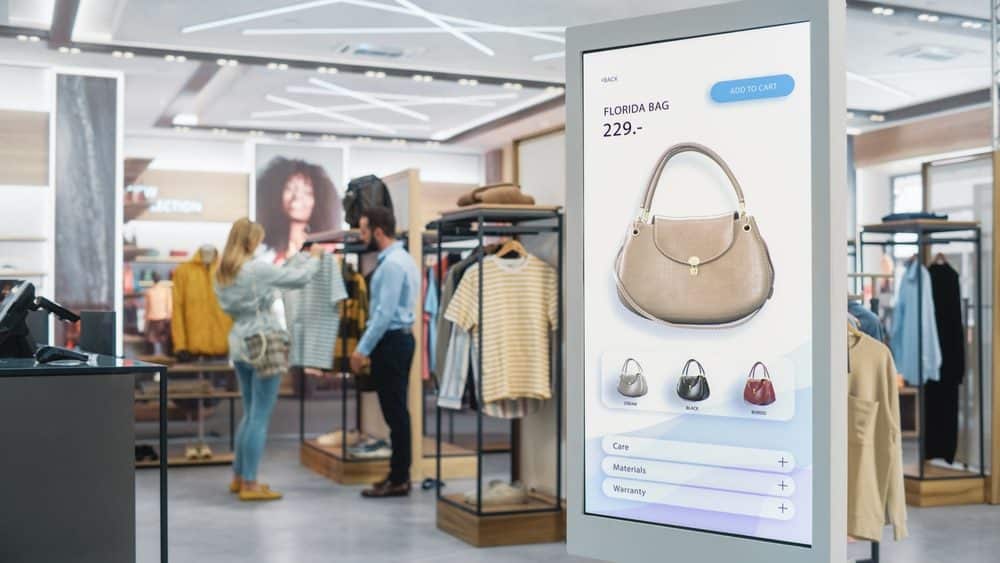Take marketing to the next level by choosing point-of-purchase displays – they enhance the consumer shopping experience because of their ability to POP up and alert customers to products that they weren’t previously aware of. Enjoy a comprehensive guide to understanding what point-of-purchase displays are, how to create them, the different types, and why this marketing tool is effective. It is time to think like a professional merchandiser and get creative with product presentations. Let’s get started.
What Are POP (Point-of-Purchase) Displays?
POP (Point-of-Purchase) displays are separate presentations of special buys in a wide range of stores. It is a freestanding marketing tool set up on a shelf or in the aisle near the marketed product.
These displays have flashy, attractive promotional signage to catch consumers’ attention. A name-brand vendor sometimes comes in to build the presentation and, in other instances, a stocker will be in charge of setting the display per a planogram.
If you are a store owner looking to take advantage of POP displays, we suggest outsourcing services to have your presentations professionally assembled. Learn how the experts do it and complete the task on your own.
The Three Goals of Point-of-Purchase Displays
Point-of-purchase displays have three main goals when stationed in a consumer retail location. They seek to educate consumers about the product, provide information to consumers about the brand, and persuade consumers to make a purchase.
Education About the Product
These valuable marketing tools first educate consumers about the product. Whether the consumer knows about the product already or is learning about it for the first time, they can always learn something new when perusing a point-of-purchase display.
Provide Information To Consumers About the Brand
Aside from product details, POPs offer brand-specific information to consumers. These include:
- Brand messaging: Each brand has a unique voice and set of values that manufacturers want to communicate to customers.
- Brand positioning: Brands use specific CTAs and slogans to set themselves apart from competitors, and to ensure customers remember them.
- Brand design: Brand-specific coloring, typography, and graphics makes brands stand out and draws new customers in.
Persuade Consumers To Make a Purchase
These displays can attract consumer attention almost instantly. Using bright and coordinating colors and strategic product placement will persuade consumers to purchase the product.
Also, including just the right amount of product on the point-of-purchase display could have potential buyers thinking they have to act now before they can no longer get the product at that very minute.
How Are Point-of-Purchase Displays Made?
Graphic designers create point-of-purchase displays using print or digital media. Rather than going full scale like a digital marketing or traditional marketing campaign that gets customers inside a store, these marketing tools focus primarily on making more sales from consumers because of the attractiveness of POP displays.
#1. Highlight a Product
Marketers choose a product that is the main focus of the presentation. Usually, it is a well-known product that consumers already know and love. A POPular product turned into a marketing presentation will do very well, whether or not it is on sale.
However, if a brand is new on the market, this display could be a great way to inform the consumer and have them consider trying the product for the first time.
#2. Create the Promotional Signage
Once marketers select a product to highlight for an in-store POP display, it is time to create promotional signage. A catchy slogan next to a picture of the product works well and gets consumers thinking about how the item can benefit their lives.
Signage companies may opt for plastic signage over cardboard because it is more energy-efficient and costs less to make. However, it is easier to have a point-of-purchase display packaged with a cardboard makeup so it is easier for a stocker or store manager to lift the box open and set the display immediately.
Marketers must consider the following when creating promotional signage:
- The connotation of the message they want to portray to the customer.
- The information they wish to communicate to the consumer.
- How they will persuade shoppers to purchase the product.
- Company slogan
- A coupon is available to grab from the display
- How retailers can cross merchandise with products in a storefront
#3. Choose How Many Shelves
Depending on the product’s size, a point-of-purchase merchandising presentation may need one or many shelves to properly present it. Of course, shelving quantity is contingent on the type of retail POP display.
#4. Set the Stage
The store manager will make the final decision on where this marketing presentation will sit in the store. For example, a center aisle display with peanut butter may be stationed next to or diagonally adjacent to jelly jars as a cross-merchandising tactic.
Cross merchandising is stationing one product with another item that usually goes together to encourage increased sales. Think of a ketchup display next to the meat cooler with hot dogs. Imagine a sidekick display of sprinkle containers suctioned to the same freezer door that leads to the ice cream.
Types of Point-of-Purchase Merchandising
 Merchandising this marketing tool is more than staging an attractive cardboard display in the middle of a grocery aisle or polishing an end cap for a promotion in the current week’s circular. Many types of in-store POP displays can make a customer stop in their tracks to take a look.
Merchandising this marketing tool is more than staging an attractive cardboard display in the middle of a grocery aisle or polishing an end cap for a promotion in the current week’s circular. Many types of in-store POP displays can make a customer stop in their tracks to take a look.
These include end caps, center aisle displays, shelf-talkers, dump bins, sidekick displays, and floor graphics. Each one has its unique purpose and special time for using it over another method.
#1. End Caps
End caps are product presentations that are staged at the end of a grocery aisle facing a central walkway. Promotional signage is the largest for this merchandising option. If you want to showcase a special buy in a current week’s circular, utilizing an end cap would be your best choice.
Just for promoting sugary beverages alone, studies have shown that grocery stores utilize end caps 68% of the time to set this product category. This may be because end cap in-store POP displays are the largest out of all the merchandising choices. Of course, a larger presentation will catch someone’s eye more so than a smaller one.
#2. Center Aisle Displays
Center aisle displays are set up on cardboard or plastic freestanding units. Promotional signage is at the top and the product is stacked in the middle to bottom of the unit. Sometimes a coupon will be available for you to grab to the left or right of the promotional signage.
Consider POP display product assembly kitting to be one step ahead of the merchandising process. We can discover your store’s needs and make the vision come to life by building the perfect display based on space, presentation, and current resources.
#3. Shelf Talkers
A shelf talker is a thin and vibrant rectangular sign affixed to an aisle’s shelf. It will include a brand’s slogan, the product name, and its key features.
If you are lucky, there may be a paper pad with coupons you can tear off to apply to your purchase. The incentive of buying a name-brand product cheaper than its retail price will influence a higher likelihood of an approved purchase decision.
#4. Dump Bins
Dump bins are large rectangular or square fixtures filled with one product category or multiple items of different categories. For example, you may see a dump bin filled with clearance items such as snacks, toys, kitchen utensils, hair accessories, and more. This merchandising option is best for smaller products that can fit a higher quantity of inventory at one time.
#5. Sidekick Displays
Sidekick displays are mini shelving units that exhibit a product creatively. They are most POPular in higher traffic store aisles or at the cash registers where most last-minute impulse buys occur. You may see sidekick displays showcasing gum, breath mints, candy bars, or other small items.
#6. Floor Graphics
Floor graphics can be interactive marketing that gets the attention of more than adult shopping. Marketers know that little ones are closer to the floor, so they will usually create them to intrigue the youngest ones in the family. A notable cereal character may be featured on the floor graphic with a fun activity such as a maze or hopscotch that leads them to the product in which the picture features.
Why Point-of-Purchase Marketing Is Effective
So why is point-of-purchase merchandising so effective in storefronts? They boost a store’s bottom line and regulate inventory using the FIFO method.
Boost a Store’s Bottom Line
Sometimes a customer will visit a store and the one item that they want will be out of stock. This can be disheartening for the customer whereas he or she may walk out of the store without any merchandise.
However, if a customer passes a point-of-purchase display, they are more likely to stop and browse it because of its unique placement next to a shelf or in the middle of an aisle. Even though they did not get what they originally visited the store to retrieve, it may be possible they walk out of the store buying something else.
Regulates Inventory
Point-of-purchase merchandising regulates inventory. Say that the display is now empty, but you have inventory in the stock room that is three months away from expiring. Restock the in-store retail POP display with this almost expired product so that it can be filtered out of the store, reduce waste, and lessen sales loss from discarding the expired product. This tactic is known as the FIFO, or ‘first in first out’, method.

The Difference Between POP Displays and POS Displays
POP displays are staged throughout the store in various areas such as end caps, center aisle, and other key locations. They affect a client’s overall shopping experience while in the heart of the store.
POS (Point-of-Sale) displays are stationed near the register. Hence its name, the products are closest to where customers will pay for their products. While they attract customer attention just like retail POP displays, this merchandising tactic encourages much more impulse purchases than its cousin.
Items on a POP display are usually more practical than what is on a POS display because they are strategically stationed throughout the store. Sure, you may have an end cap of snack cakes or sugary cereals from time to time on a POP display. However, some items could be healthier pantry options. Products nearest the register include magazines, candy, small toys, and other filler items that are not needed.
Final Thoughts
With industry-leading certifications at MDI, we can have your business on its way to merchandising success. Consider us next time you need help staging a POP display for your establishment.
